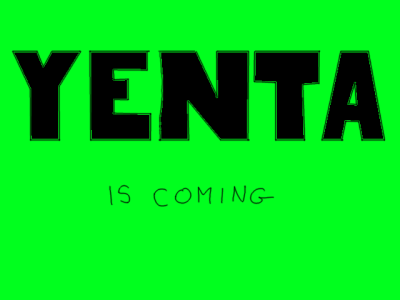- Matchmaker, part 1
- Matchmaker, part 2
(I spent more time thinking about business schemes [and girls] when I got to college than I did about my schoolwork. One idea was for a service that would deliver food from local restaurants to starving students sick of the slop they served us at the Kiltie [“kill-me”] Cafe. My plan never got off the drawing board, but the time must have been right for that idea because within a couple of years, several cities had exactly that. It wasn’t the first time I had an idea that I didn’t capitalize on, and that others later did. Pittsburgh’s restaurant-delivery service was called Wheel Deliver. One of the agents who worked the phones there was named Andrea. “And today that woman is my wife.”)
I got to work writing a new version of the matchmaking software, this time in Turbo Pascal on an IBM PC, hundreds of times faster than the version that Chuck and I had written in BASIC on the Sol-20. My new friends David and Julie (yes, the same David and Julie) helped me to design the questionnaire. It was still two years before the birth of desktop publishing so everything was typewritten or hand-lettered. The master copy of the questionnaire was literally cut-and-pasted together from dozens of bits of paper.
I took some of my $300 budget and headed to Kinko’s, where I ran off reams of copies of the questionnaire and some teaser posters I had conceived as the ad campaign:

The name, Yenta, was taken from the matchmaker’s name in Fiddler on the Roof. I stapled those posters all over campus and managed to create some “buzz.”
Meanwhile I needed to find someone with a computer and a printer I could use when I set up the station for running off customers’ result lists. In 1984 those were still pretty hard to come by. I allocated another $50 as incentive and placed an ad on the campus bulletin board. The taker was a fellow freshman named Bruce, who took my $50, loaned me his equipment, and became a lifelong friend. (A few years later, I visited him often in the house he shared with my other friend, Steve. The house was divided into two apartments. One day on my way to visit Bruce and Steve, I met Andrea, the downstairs tenant. “And today that woman is my wife.”)
Once we had the needed equipment we ran off another batch of posters telling people what Yenta was and to check their campus mailboxes for questionnaires, to fill them out and turn them in by such-and-such a date, and to show up at the student center during certain hours on certain days to collect their match results, just five dollars for a printed list.
The response was good enough to require multiple miserable late nights of tedious data entry, which was all too familiar to me but new to David and Julie, who had become my equal partners and shared much of the burden. At the appointed times we set up Bruce’s computer in “Grey Matter” and served our customers. It all went very smoothly.
In the end, Yenta made a profit of around $900, which David and Julie and I split. It was the most successful venture in the entrepreneurship club that semester, and I parlayed my success into a date with the club’s president, a sophomore named Robin who was a Tri-Delt, a sorority about which I had heard some exciting rumors. The date was disastrous, however, which I guess you can take as a comment on the fallibility of computer matchmaking, sort of.
(To be continued…)